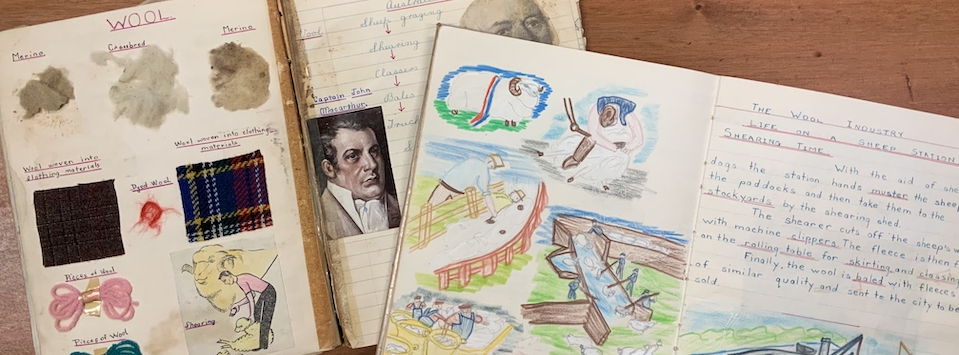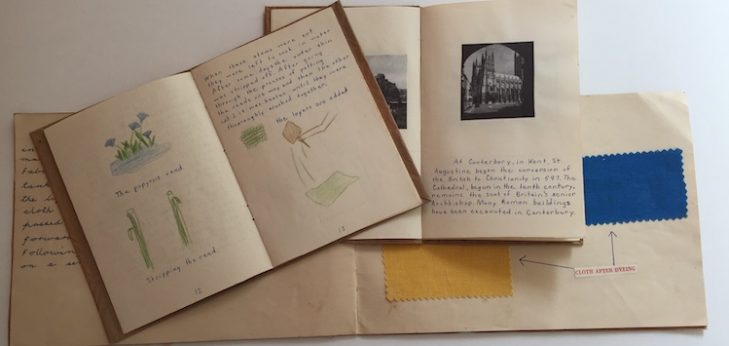1960s school projects
Dianne Robertson and Robyn Minard attended North Ryde Public School in the 1950s and 1960s. In this oral history they recount their memories of the school projects they completed at home in their primary years.
Home assignments
The school projects we undertook in the 1960s were actually called home assignments as they had to be totally researched, hand written and completed at home. Then the finished product was brought to school to be assessed.
Working from home gave us the advantage of being able to complete the assignment at our own pace, however we needed to source our own information and sometimes even draw our own illustrations.
Home assignment – cotton
One of our favourite home assignments was all about cotton. How did the cotton that grew on a plant end up as a piece of cloth? We soon found out.
We were able to gather most of the resources we needed during a visit to the Royal Agricultural Society’s Show, now known as the Royal Easter Show. This annual event brought the city and the country together where we were able to pat goats, admire the bulls and watch tiny yellow chicks hatching. It was also an opportunity for companies from miles around to display their wares.
Fortunately a company named Actil was promoting their ultra modern spinning machines in their cotton manufacturing. So, gathering as many brochures, pamphlets and samples as possible, we were ready and able to complete our projects. We learnt that raw cotton must be cleaned then carded to prepare it for spinning and finally woven. With bleaching and dying, the cloth was ready and still has many uses to this day.
Dianne’s 6th Class project books, 1966. They include a project on cotton, the history of writing and a project on Great Britain. (Personal collection of D Robertson)
Homemade paste
To finish our home assignment, we were required to cover it with brown paper. We used a combination of sticky tape and homemade paste, now known as glue. Our paste was a mixture of plain flour and water which we would blend in an egg cup till it was just the right consistency, then apply it to the page with the tip of one finger. If it had too much water, it didn’t stick and if we made too much paste it never stayed fresh, and we’d have to throw it out.
Creating books
At times our home assignments focused on creating our own book, hence learning about the various aspects of publication. We had to be the author, the illustrator, include individual chapters and a contents page then number each page. Of course, not forgetting to cover it with brown paper.
Great Britain project
We recall creating a book on Great Britain. In it we wrote of the beauty of the giant causeways of Ireland, mountains, lakes and rivers of Wales and the stretches of water of Scotland. We included the rich parks and cathedrals of England and its castles, churches and palaces dating back centuries.
Fortunately, we were able to paste in pictures to decorate our books. How difficult it would have been as a child to draw a cathedral! We also sketched our illustrations which sat beside our well researched information.
History of writing project
However, from time to time we sketched our illustrations which sat beside our well researched information. Our favourite assignment was on the history of writing focusing on how civilizations communicated. A fascinating fact that we shall never forget was the beauty and common sense used by the Egyptians with their hieroglyphics and their small drawn figures. If they wrote the surname ‘Smith ‘as a word and they really wanted to write ‘Mr Smith‘ then they drew a picture of a little man in front of the word. How clever!
Questions and activities for students
- Do you complete projects as part of you homework? What are they called?
- What is similar and different about the way you present your home projects today?
- What has been your most favourite home project? Why?
Activity
- Use the recipe on the side of the page to make home-made paste. Test it out by pasting some coloured shapes onto paper.


